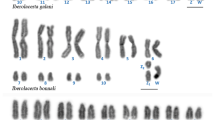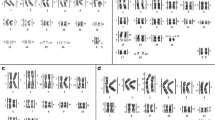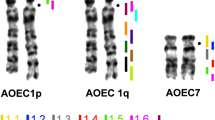Abstract
Gekkotan lizards are a highly specious (∼1600 described species) clade of squamate lizards with nearly cosmopolitan distribution in warmer areas. The clade is primarily nocturnal and forms an ecologically dominant part of the world nocturnal herpetofauna. However, molecular cytogenetic methods to study the evolution of karyotypes have not been widely applied in geckos. Our aim here was to uncover the extent of chromosomal rearrangements across the whole group Gekkota and to search for putative synapomorphies supporting the newly proposed phylogenetic relationships within this clade. We applied cross-species chromosome painting with the recently derived whole-chromosomal probes from the gekkonid species Gekko japonicus to members of the major gekkotan lineages. We included members of the families Diplodactylidae, Carphodactylidae, Pygopodidae, Eublepharidae, Phyllodactylidae and Gekkonidae. Our study demonstrates relatively high chromosome conservatism across the ancient group of gekkotan lizards. We documented that many changes in chromosomal shape across geckos can be attributed to intrachromosomal rearrangements. The documented rearrangements are not totally in agreement with the recently newly erected family Phyllodactylidae. The results also pointed to homoplasy, particularly in the reuse of chromosome breakpoints, in the evolution of gecko karyotypes.



Similar content being viewed by others
Abbreviations
- GJA:
-
Gekko japonicus
- PCR:
-
Polymerase chain reaction
- qPCR:
-
Quantitative polymerase chain reaction
- DOP-PCR:
-
Degenerate oligonucleotide primed PCR
- FISH:
-
Fluorescence in situ hybridization
- dUTP:
-
Deoxy-uridine-5′-triphosphate
- SSC:
-
Saline sodium citrate
- DAPI:
-
4′,6-Diamidino-2-phenylindole
References
Alföldi J, Di Palma F, Grabherr M, Williams C, Kong L, Russell EP, Lowe CB, Glor RE, Jaffe JD, Ray DA, Boissinot S, Shedlock AM, Botka C, Castoe TA, Colbourne JK, Fujita MK, Godinez- Moreno R, Ten-Hallers BF, Haussler D, Heger A, Heiman D, Janes DE, Johnson J, De Jong PJ, Koriabine MY, Lara M, Novick PA, Organ CL, Peach SE, Poe S, Pollock DD, De Queiroz K, Sanger T, Searle S, Smith JD, Smith Z, Swofford R, Turner-Maier J, Young JS, Zadissa A, Edwards SV, Glenn TC, Schneider CJ, Losos JB, Lander ES, Breen M, Ponting CP, Lindblad-Toh K (2011) The genome of the green anole lizard and a comparative analysis with birds and mammals. Nature 477:587–591
Aprea G, Andreone F, Fulgione D, Petraccioli A, Odierna G (2013) Chromosomal rearrangements occurred repeatedly and independently during species diversification in Malagasy geckos, genus Paroedura. Afr Zool 48:96–108
Bansal R, Karanth KP (2010) Molecular phylogeny of Hemidactylus geckos (Squamata: Gekkonidae) of the Indian subcontinent reveals a unique Indian radiation and an Indian origin of Asian house geckos. Mol Phylogenet Evol 57:459–465
Bauer AM, Masroor R, Titus-Mcquillan J, Heinicke MP, Daza JD, Jackman TR (2013) A preliminary phylogeny of the Palearctic naked-toed geckos (Reptilia: Squamata: Gekkonidae) with taxonomic implications. Zootaxa 3599:301–324
Carranza S, Arnold EN (2006) Systematics, biogeography, and evolution of Hemidactylus geckos (Reptilia: Gekkonidae) elucidated using mitochondrial DNA sequences. Mol Phylogenet Evol 38:531–545
Červenka J, Kratochvíl L, Frynta D (2008) Phylogeny and taxonomy of the Middle Eastern geckos of the genus Cyrtopodion and their selected relatives. Zootaxa 1931:25–36
Deakin JE, Ezaz T (2014) Tracing the evolution of amniote chromosomes. Chromosoma 123:201–216
Dixon JR, Kroll JC (1974) Resurrection of the generic name Paroedura for the phyllodactyline geckos of Madagascar, and description of a new species. Copeia 1974:24–30
Estes R, de Queiroz K, Gauthier J (1988) Phylogenetic relationships within Squamata. In: Estes R, Pregill J (eds) Phylogenetic relationships of the lizard families. Stanford University Press, Stanford, pp 119–281
Ferguson-Smith MA, Trifonov V (2007) Mammalian karyotype evolution. Nat Rev Genet 8:950–962
Gamble T, Bauer AM, Greenbaum E, Jackman TR (2008a) Out of the blue: a novel, trans-Atlantic clade of gecko lizards (Gekkota, Squamata). Zool Scr 37:355–366
Gamble T, Bauer AM, Greenbaum E, Jackman TR (2008b) Evidence for Gondwanan vicariance in an ancient clade of gecko lizards. J Biogeogr 35:88–104
Gamble T, Bauer AM, Colli GR, Greenbaum E, Jackman TR, Vitt LJ, Simons AM (2011) Coming to America: multiple origins of New World geckos. J Evol Biol 24:231–244
Gamble T, Greenbaum E, Jackman TR, Russell AP, Bauer AM (2012) Repeated origin and loss of adhesive toepads in geckos. PLoS One 7:e39429
Gamble T, Geneva AJ, Glor RE, Zarkower D (2014) Anolis sex chromosomes are derived from a single ancestral pair. Evolution 68:1027–1041
Gorman GC (1973) The chromosomes of the Reptilia, a cytotaxonomic interpretation. In: Chiarelli AB, Capanna E (eds) Cytotaxonomy and vertebrate evolution. Academic, New York, pp 349–424
Gorman GC, Gress F (1970) Sex chromosomes of a pygopodid lizard, Lialis burtonis. Experientia 26:206–207
Graphodatsky AS, Trifonov VA, Stanyon R (2011) The genome diversity and karyotype evolution of mammals. Mol Cytogenet 4:22
Griffin DK, Robertson LBW, Tempest HG, Skinner BM (2007) The evolution of the avian genome as revealed by comparative molecular cytogenetics. Cytogenet Genome Res 117:64–77
Grismer LL (1988) The phylogeny, taxonomy, classification and biogeography of eublepharid geckos (Reptilia: Squamata). In: Estes R, Pregill J (eds) Phylogenetic relationships within Squamata. Stanford University Press, Stanford, pp 369–469
Han D, Zhou K, Bauer AM (2004) Phylogenetic relationships among gekkotan lizards inferred from C‐mos nuclear DNA sequences and a new classification of the Gekkota. Biol J Linn Soc 83:353–368
Hillier LW, Miller W, Birney E, Warren W, Hardison RC, Ponting CP, … Dodgson JB (2004) Sequence and comparative analysis of the chicken genome provide unique perspectives on vertebrate evolution. Nature 432: 695–716
Johnson Pokorná M, Rovatsos M, Kratochvíl L (2014) Sex chromosomes and karyotype of the (nearly) mythical creature, the Gila monster, Heloderma suspectum (Squamata: Helodermatidae). PLoS One 9:e104716
Kasai F, O’Brien PCM, Martin S, Ferguson-Smith MA (2012) Extensive homology of chicken macrochromosomes in the karyotypes of Trachemys scripta elegans and Crocodylus niloticus revealed by chromosome painting despite long divergence times. Cytogenet Genome Res 136:303–307
Kawai A, Ishijima J, Nishida C, Kosaka A, Ota H, Kohno SI, Matsuda Y (2009) The ZW sex chromosomes of Gekko hokouensis (Gekkonidae, Squamata) represent highly conserved homology with those of avian species. Chromosoma 118:43–51
King M (1987a) Monophyleticism and polyphyleticism in the Gekkonidae: a chromosomal perspective. Aust J Zool 35:641–654
King M (1987b) Chromosomal evolution in the Diplodactylinae (Gekkonidae, Reptilia). 1. Evolutionary relationships and patterns of change. Aust J Zool 35:507–531
King M (1990) Chromosomal and immunogenetic data: a new perspective on the origin of Australia’s reptiles, in Olmo E (ed) Cytogenetics of amphibians and reptiles pp 153–180
King M, Mengdon G (1990) Chromosomal evolution in the Diplodactylidae (Gekkonidae: Reptilia) II. Chromosomal variability between New Caledonian species. Aust J Zool 38:219–226
Kluge AG (1983) Cladistic relationships among gekkonid lizards. Copeia 1983:465–475
Kluge AG, Nussbaum RA (1995) A review of African-Madagascan gekkonid lizard phylogeny and biogeography (Squamata). Misc Publ Mus Zool Mich 183:1–28
Koubová M, Johnson Pokorná M, Rovatsos M, Farkačová K, Altmanová M, Kratochvíl L (2014) Sex determination in Madagascar geckos of the genus Paroedura (Squamata: Gekkonidae): are differentiated sex chromosomes indeed so evolutionary stable? Chromosome Res 22:441–452
Manilo VV (1996) Peculiarities of the karyotypes in the family Gekkonidae (Sauria, Reptilia). Communication 3. Genus Tenuidactylus. Vestnik Zool 32:31–37
Matsubara K, Tarui H, Toriba M, Yamada K, Nishida-Umehara C, Agata K, Matsuda Y (2006) Evidence for different origin of sex chromosomes in snakes, birds, and mammals and step-wise differentiation of snake sex chromosomes. Proc Natl Acad Sci U S A 103:18190–18195
Matsubara K, Sarre SD, Georges A, Matsuda Y, Graves JAM, Ezaz T (2014a) Highly differentiated ZW sex microchromosomes in the Australian Varanus species evolved through rapid amplification of repetitive sequences. PLoS One 9:e95226
Matsubara K, Gamble T, Matsuda Y, Zarkower D, Sarre SD, Georges A, Graves JAM, Ezaz T (2014b) Non-homologous sex chromosomes in two geckos (Gekkonidae: Gekkota) with female heterogamety. Cytogenet Genome Res 143:251–258
Oguiura N, Ferrarezzi H, Batistic RF (2010) Cytogenetics and molecular data in snakes: a phylogenetic approach. Cytogenet Genome Res 127:128–142
Pokorná M, Rábová M, Ráb P, Ferguson-Smith MA, Rens W, Kratochvíl L (2010) Differentiation of sex chromosomes and karyotypic evolution in the eye-lid geckos (Squamata: Gekkota: Eublepharidae), a group with different modes of sex determination. Chromosome Res 18:809–820
Pokorná M, Giovannotti M, Kratochvíl L, Kasai F, Trifonov VA, O’Brien PC, Caputo V, Olmo E, Ferguson-Smith MA, Rens W (2011) Strong conservation of the bird Z chromosome in reptilian genomes is revealed by comparative painting despite 275 million years divergence. Chromosoma 120:455–468
Pokorná M, Giovannotti M, Kratochvíl L, Caputo V, Olmo E, Ferguson-Smith MA, Rens W (2012) Conservation of chromosomes syntenic with avian autosomes in squamate reptiles revealed by comparative chromosome painting. Chromosoma 121:409–418
Pyron RA, Burbrink FT, Wiens JJ (2013) A phylogeny and revised classification of Squamata, including 4161 species of lizards and snakes. BMC Evol Biol 13:93
Rens W, O’Brien PCM, Yang F, Graves JAM, Ferguson-Smith MA (1999) Karyotype relationships between four distantly related marsupials revealed by reciprocal chromosome painting. Chromosome Res 7:461–474
Rens W, Fu B, O’Brien PCM, Ferguson-Smith MA (2006) Cross-species chromosome painting. Nat Protoc 1:783–790
Rovatsos M, Altmanová M, Pokorná M, Kratochvíl L (2014a) Conserved sex chromosomes across adaptively radiated Anolis lizards. Evolution 68:2079–2085
Rovatsos M, Pokorná M, Altmanová M, Kratochvíl L (2014b) Cretaceous park of sex determination: sex chromosomes are conserved across iguanas. Biol Lett 10:20131093
Rovatsos M, Altmanová M, Johnson Pokorná M, Kratochvíl L (2014c) Novel X-linked genes revealed by qPCR in the green anole, Anolis carolinensis. G3:114
Shibaike Y, Takahashi Y, Arikura I, Iiizumi R, Kitakawa S, Sakai M, Imaoka C, Shiro H, Tanaka H, Akakubo N, Nakano M, Watanabe M, Ohne K, Kubota S, Kohno S, Ota H (2010) Chromosome evolution in the lizard genus Gekko (Gekkonidae, Squamata, Reptilia) in the east Asian islands. Cytogenet Genome Res 127:182–190
Skinner BM, Griffin DK (2011) Intrachromosomal rearrangements in avian genome evolution: evidence for regions prone to breakpoints. Heredity 108:37–41
Šmíd J, Carranza S, Kratochvíl L, Gvoždík V, Nasher AK, Moravec J (2013) Out of Arabia: a complex biogeographic history of multiple vicariance and dispersal events in the gecko genus Hemidactylus (Reptilia: Gekkonidae). PLoS One 8:e64018
Srikulnath K, Nishida C, Matsubara K, Uno Y, Thongpan A, Suputtitada S, Apisitwanich S, Matsuda Y (2009) Karyotypic evolution in squamate reptiles: comparative gene mapping revealed highly conserved linkage homology between the butterfly lizard (Leiolepis reevesii rubritaeniata, Agamidae, Lacertilia) and the Japanese four-striped rat snake (Elaphe quadrivirgata, Colubridae, Serpentes). Chromosome Res 17:975–986
Srikulnath K, Matsubara K, Uno Y, Nishida C, Olsson M, Matsuda Y (2014) Identification of the linkage group of the Z sex chromosomes of the sand lizard (Lacerta agilis, Lacertidae) and elucidation of karyotype evolution in lacertid lizards. Chromosoma 123:563–575
Townsend TM, Larson A, Louis E, Macey JR (2004) Molecular phylogenetics of Squamata: the position of snakes, amphisbaenians, and dibamids, and the root of the squamate tree. Syst Biol 53:735–757
Trifonov VA, Giovannotti M, O’Brien PC, Wallduck M, Lovell F, Rens W, Parise-Maltempi PP, Caputo V, Ferguson-Smith MA (2011) Chromosomal evolution in Gekkonidae. I. Chromosome painting between Gekko and Hemidactylus species reveals phylogenetic relationships within the group. Chromosome Res 19:843–855
Uetz P, Hošek J (eds) (2014) The reptile database. Available at http://www.reptile-database.org. Accessed August 1, 2014
Underwood G (1954) On the classification and evolution of geckos. Proc Zool Soc 124:469–492
Uno Y, Nishida C, Tarui H, Ishishita S, Takagi C, Nishimura O, Ishijima J, Ota H, Kosaka A, Matsubara K, Murakami Y, Kuratani S, Ueno N, Agata K, Matsuda Y (2012) Inference of the protokaryotypes of amniotes and tetrapods and the evolutionary processes of microchromosomes from comparative gene mapping. PLoS One 7:e53027
Warren WC, Clayton DF, Ellegren H, Arnold AP, Hillier LW, Künstner A, Searle S, White S, Vilella AJ, Fairley S, Heger A, Kong L, Ponting CP, Jarvis ED, Mello CV, Minx P, Lovell P, Velho TA, Ferris M, Balakrishnan CN, Sinha S, Blatti C, London SE, Li Y, Lin YC, George J, Sweedler J, Southey B, Gunaratne P, Watson M, Nam K, Backström N, Smeds L, Nabholz B, Itoh Y, Whitney O, Pfenning AR, Howard J, Völker M, Skinner BM, Griffin DK, Ye L, McLaren WM, Flicek P, Quesada V, Velasco G, Lopez-Otin C, Puente XS, Olender T, Lancet D, Smit AF, Hubley R, Konkel MK, Walker JA, Batzer MA, Gu W, Pollock DD, Chen L, Cheng Z, Eichler EE, Stapley J, Slate J, Ekblom R, Birkhead T, Burke T, Burt D, Scharff C, Adam I, Richard H, Sultan M, Soldatov A, Lehrach H, Edwards SV, Yang SP, Li X, Graves T, Fulton L, Nelson J, Chinwalla A, Hou S, Mardis ER, Lancet D (2010) The genome of a songbird. Nature 464:757–762
Wiens JJ, Hutter CR, Mulcahy DG, Noonan BP, Townsend TM, Sites JW, Reeder TW (2012) Resolving the phylogeny of lizards and snakes (Squamata) with extensive sampling of genes and species. Biol Lett 8:1043–1046
Yang F, Carter NP, Shi L, Ferguson-Smith MA (1995) A comparative study of karyotypes of muntjacs by chromosome painting. Chromosoma 103:642–652
Yaseen AE, Hassan HA, Kawashti IS (1995) Chromosomes of three Egyptian lizards of the family Gekkonidae (Squamata: Reptilia). Cytologia 60:233–242
Acknowledgments
The authors would like to express their gratitude to P. Ráb for the ongoing support, to J. Červenka for animal care and two anonymous reviewers for constructive comments. The project was supported by Czech Science Foundation (project no. 506/10/0718).
Author information
Authors and Affiliations
Corresponding author
Additional information
Responsible Editor: Fengtang Yang
Rights and permissions
About this article
Cite this article
Pokorná, M.J., Trifonov, V.A., Rens, W. et al. Low rate of interchromosomal rearrangements during old radiation of gekkotan lizards (Squamata: Gekkota). Chromosome Res 23, 299–309 (2015). https://doi.org/10.1007/s10577-015-9468-6
Received:
Revised:
Accepted:
Published:
Issue Date:
DOI: https://doi.org/10.1007/s10577-015-9468-6




